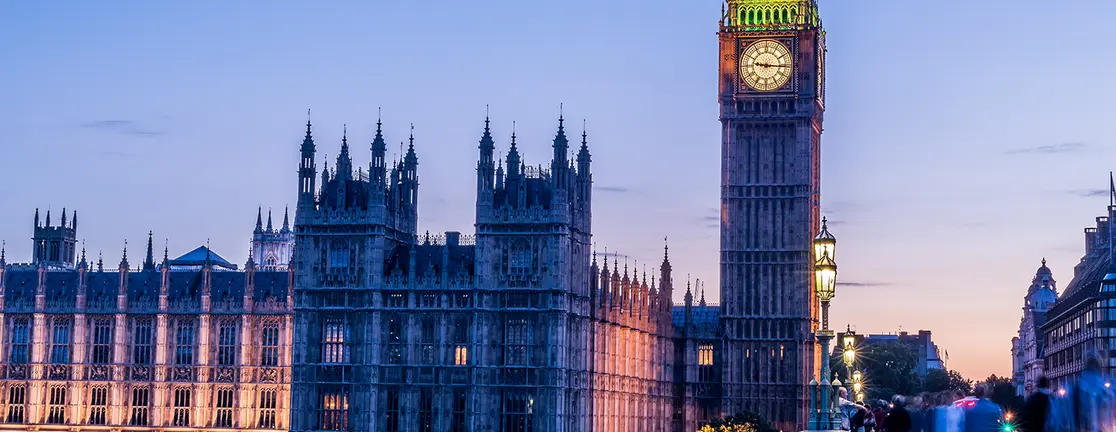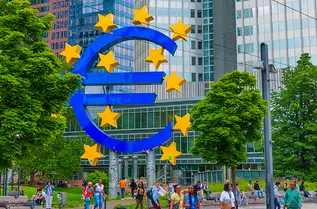Summary
- Britain’s Labour Party won a large majority in parliamentary elections held on July 4 and will return to power for the first time in 14 years. The Conservative Party suffered its worst-ever performance.
- Labour faces considerable economic challenges and has limited fiscal room to lift investment, productivity and growth, especially given its campaign commitment to fiscal prudence.
- Foreign policy, notably improving European Union relations, may be deployed to tackle economic challenges and to enhance the UK’s global reputation and influence.
- The Labour Party’s win takes British government bonds a step closer to becoming a safe haven with the UK scoring well on inflation and fiscal dynamics, as well as on political risk.
- We view the results as broadly neutral for UK equities given Labour’s policies are unlikely to diverge massively from those implemented by the previous government. While large multinationals, which dominate the UK equity market, will be less sensitive to the election result, domestic-focused companies in sectors such as energy and housebuilding may be more affected.
- Global factors and the Bank of England’s policy choices will be the main drivers of sterling, which may strengthen gradually over the course of the second half of the year.
Britain’s Labour Party returned to power for the first time in 14 years after winning a large majority in parliamentary elections that were held on July 4. Labour, led by Keir Starmer, won more than 410 of the 650 seats in the House of Commons, while the Conservative Party suffered its worst-ever performance.
The scale of Labour’s win was largely anticipated given opinion polls had put the party about 20 percentage points ahead of the Conservatives for some time. Labour had sought to maintain this lead during the election campaign by presenting largely centrist, pro-growth policies and a commitment to fiscal prudence. Moreover, investors don’t expect its policies to diverge massively from those implemented by the outgoing Conservatives. The immediate reaction of financial markets to the election result was therefore relatively muted.
The scale of Starmer’s challenges are, however, considerable given his government has limited fiscal leeway to tackle the long-term problems facing the economy (Chart below). Lifting investment, productivity and growth will require his cabinet to deploy appropriate incentives rather than budget levers. As a result, the new prime minister may try to deploy foreign policy as a way of lifting some of the hurdles to growth and enhancing Britain’s global reputation and influence. Building better relations with the European Union will therefore be high on the agenda.
What is the macroeconomic and policy outlook?
The new government inherits a difficult macroeconomic backdrop, a legacy of low investment, low productivity and low growth whose roots lie deeper than the recent impact of Covid and high energy prices. The starting point is a still restrictive monetary policy and no fiscal space for stimulus measures. Starmer will have to live with a very subdued medium-term growth outlook, with tight fiscal constraints, and primarily work on supply side policies to raise potential growth in the long term. But a period of political stability and prudent polices bodes well for favourable external sentiment, including a gradual repair of relations with the EU, and market stability.
The change of government does not change our near-term growth outlook. We continue to expect around 0.8 percent growth this year and about 1.2 percent in 2025 as the economy stages a very gradual return to potential growth. This recovery will be supported by a continuing decline in the inflation rate that will allow the Bank of England to ease policy rates to below 4.0 percent by the end of next year (see Chart below). Together with relatively low unemployment, this should put a floor on consumption, begin to ease the mortgage refinancing burden, and gradually increase investment.
The government’s dilemma however, will be to navigate the tight fiscal constraints (see Chart below). The independent Office for Budget Responsibility (OBR) estimates that the macroeconomic environment is weaker than at the time of the budget unveiled in March this year, when the Chancellor was able to inject a small stimulus, of about 0.2 percent of GDP over five years. But that stimulus will be more than undone by the rising tax burden, with income tax thresholds still frozen, and a higher interest burden on public debt. There will also be higher demands on public services such as education and health. Most forecasters expect fiscal tightening of about 0.5 to 1.0 percent of GDP will be necessary for the next five years if the government abides by its pledge to keep to the fiscal framework and cash borrowing limits.
Labour’s fiscal programme recognises these constraints, with expenditure measures that only tinker at the margin and are funded by new taxes. New spending commitments – more staffing in health and education, and more green investment – would add much less than £50 billion to expenditure in an aggregate government expenditure envelope of almost £1.2 trillion. Starmer plans to fund this additional expenditure by tightening the tax regime for non-domiciles, reducing tax avoidance, introducing VAT on private schooling, and imposing windfall taxes on oil and gas companies. While this will ensure a prudent fiscal policy, it won’t move the macro needle on the growth barometer.
Raising growth over the long term will require more attention to the supply side. And that will mean addressing skill shortages in the UK workforce, increasing investment in infrastructure (which is partly what has held back corporate investment), and providing incentives for investment – all of which are necessary to increase productivity and growth. This is a tall agenda, but one that will have to be tackled if the UK is to get out of its low growth rut. Starmer has much of this on his policy agenda but will have to make progress on this mainly with appropriate incentives rather than looking for fiscal space.
What will be the new government’s key foreign policy goals?
While Labour will have to focus on many domestic challenges, foreign policy will be important to Starmer given his party hopes to deploy this as a tool to tackle economic challenges at home and to enhance the UK’s global reputation and influence.
EU relations will be at the top of the agenda. Starmer’s team explicitly stated during the election campaign that Labour will not seek to re-join the EU, the customs union or the single market. These statements were in response to reports that re-joining the customs union would be a priority for a new Labour government.
Instead, the ambitions for better EU relations are now centred around a narrow set of policies such as a veterinary agreement that could facilitate trade in perishable goods, artist visas and youth mobility. The main ambition is to achieve a somewhat more beneficial outcome for the UK from the Brexit deal.
The UK will also aim for better relations with the EU by pushing security agreements that are wider in scope. Current ideas include putting issues such as economic relations and collaboration on climate change under the security umbrella, in the hope that such a security agreement could improve UK-EU relations without having to go down the politically contentious ‘renegotiate Brexit’ path.
The UK will therefore seek to maximise its foreign policy strengths. Its military and nuclear capabilities will be particularly coveted should Donald Trump return to office as US President and raise questions over the scale of security protections that the United States would continue to provide Europe. Its intelligence and diplomatic networks around the world, as well as its soft power throughout the Commonwealth are also a strong point. And good UK-US relations are another lever that UK could emphasise in its dealings with the EU.
Foreign policy will be important to Starmer given his party hopes to deploy this as a tool to tackle economic challenges at home.
However, the path to better EU relations will not be straightforward. Many EU leaders may be reluctant to sign new agreements that could be ripped up again in a few years if Starmer fails to win a second term.
And the next EU Commission will have other pressing challenges, including defence, new industrial policies, its relationship with China and the United States, and a larger percentage of far-right parties sitting in EU parliaments. The UK relationship may simply not be an important enough priority against this backdrop. There are also currently few regular forums in which UK and EU politicians meet bilaterally so it will take time for relationships to deepen and trust to re-emerge.
However, given today’s geopolitical context, the EU it is likely to be more receptive to working on a closer EU-UK relationship than in previous years. It will also consider that being more open to a pro-European government now, and easing some of the economic burden Brexit has created for the UK, reduces the chances of a protest vote at the next UK parliamentary election in 2029.
Despite campaign rhetoric, it is likely that the Labour government will become more explicit about deepening EU ties now that is in power. If its main goal is to improve the UK’s economic outlook, the easiest way to do this is by re-entering the customs union, in particular if its attempts to getting closer to the EU via a security agreement do not achieve the required results. In the meantime, investors should watch out for the ‘baby steps’ in between. For example, the EU-US trade and technology council, which was launched in 2021 and aims to increase collaboration on trade, economic and technological issues, could be a format the that the UK and EU could replicate.
A likely starting point of improving EU-UK relationship could be made on July 18, as the leaders of the European Political Community, an alliance of European countries that extends beyond EU member states, will meet on UK soil on July 18, with Starmer as the host.
What are the investment implications?
Fixed Income: Starmer’s election takes British government bonds a step closer to becoming a safe haven with the UK scoring well on inflation and fiscal dynamics, as well as on political risk. A re-rating is merited and would be a big turnaround after the volatility seen during the years of UK political uncertainty that started with Brexit in 2016 and continued through Liz Truss’ short tenure in as prime minister in 2022, which was marked by a sharp increase in yields and term premia.
The new government’s limited room for fiscal manoeuvre and the imminent start of the Bank of England’s rate cutting cycle leads us to favour UK government bonds, both in absolute terms and also relative to their US, German and French counterparts. This is especially the case given debt-to-GDP dynamics could be more worrying in the United States and in some euro zone countries.
The UK credit market also has some attractions but given liquidity is lower than in the US and euro zone, we would like to see more issuance and more secondary-market activity to further reinforce our positions.
While UK fixed income doesn’t have a huge weight in global benchmarks, there may be a case for international investors to reconsider their strategic allocation given it offers a way to add a good-quality yield with interesting diversification characteristics.
Equities: We view the election results as broadly neutral for UK equity markets given the large poll leads have given stocks plenty of time to reflect this outcome. Moreover, Labour’s plans do not represent a massive deviation in policies from the outgoing Conservative party.
In terms of market capitalisation, the UK equity market is dominated by multinationals that earn the majority of their revenue from outside the UK, in sectors such as pharmaceuticals, mining and staples. The share price of these companies will therefore be less sensitive to the election outcome.
UK companies with a greater domestic focus will be more affected. The political consensus around the need to reduce carbon emissions, and Labour’s Green Prosperity plan for a net zero carbon electricity system by 2030 are a constructive backdrop for utilities that have exposure to UK renewable power generation and UK networks.
The Labour win may be less positive for the broader energy sector given the party wants to increase and extend the energy profits levy by a further 3 percentage points from 35% and remove some investment allowances linked to the levy. The impact on UK-listed international oil companies is not, however, likely to be significant given the diversified geographical exposure of these businesses.
Labour’s agenda also includes increasing the supply of affordable housing, with plans to allow land acquisitions and development, and easier planning. This would all be positive for UK housebuilders, which would also stand to benefit from a cut in interest rates by the BoE.
Any equity market slippage or volatility in the wake of the elections may present some opportunities to add to UK exposure given the UK market is currently trading at around 11 times forward/price earnings, which is fairly cheap compared with its peers, and has a dividend yield of almost 4%. It is also a lower-beta defensive market that exhibits a higher return on equity than its continental European counterpart, so stands to benefit if there are bouts of increased volatility as has been the case over the past two weeks after European parliament elections and the announcement of a snap legislative election in France.
Foreign Exchange: While sterling has a propensity to act as a pressure valve during times of political uncertainty, a widespread consensus that Labour would win the election and the new government’s limited room for policy manoeuvre mean that trading in the pound has been, and should remain, relatively calm.
We have been cautious on sterling most of this year, but think the pound is approaching a more positive tipping point. Global factors and the Bank of England’s decisions, rather than domestic politics, will be the main drivers for sterling in the coming months. Both endorse the view that sterling will strengthen gradually over the course of the second half of 2024.
We have been cautious on sterling most of this year, but think the pound is approaching a more positive tipping point.
On the domestic front, Britain’s growth prospects and its private sector’s debt-service ratio, which remains well below historical averages despite the high interest rate environment, will be supportive. So will UK interest rates, which are relatively high compared with most other G10 currencies.
And uncertainty about the global macroeconomic outlook is unlikely to translate into broader FX market volatility this time. One of the key reasons for this is the U.S. Federal Reserve’s tilt towards easing. Additionally, the dollar is expected to gradually depreciate after the Fed delivers its first of the cycle.
While we see sterling gaining a bit of ground against the dollar, we do not expect much scope for the pound to outperform significantly in trade-weighted terms. The currency is currently in the middle of the rankings in our valuation framework and we see only limited potential upside against the euro and most cyclical currencies in the G10.
With the contribution of
- Annalisa Usardi
- Federico Cesarini
- Swaha Pattanaik







